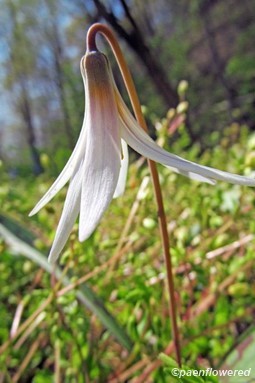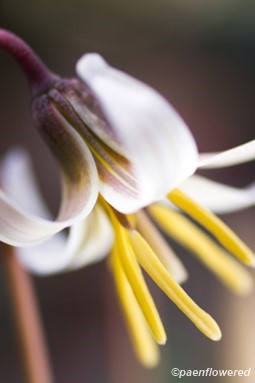Erythronium albidum
Erythronium albidum white trout-lily
This species is found from New York State west to Kansas and eastern Oklahoma. It tends to be uncommon in the south and absent in New England. It has been officially documented in all of the counties of extreme western Pennsylvania and in scattered locations in the eastern and central part of the state.
Another common name for this species is white fawn lily or white dog’s-tooth violet (though it is not a violet). This plant is considered a distinct species from the yellow trout lily, not just a color variety. Like the yellow species, (E. americanum), it is a member of the lily family. The pair of lance-shaped, mottled leaves is similar to those of the Yellow Trout Lily but perhaps more narrow. Part of one of these leaves can be seen in the photograph. The pattern on the leaves is said to resemble the body of a brook trout. Plants with one leaf do not produce flowers. Each plant stands about 10-15 cm tall with the lily-like flower hanging downwards from a slim flower stalk. This makes it necessary to get very close to or on the ground to get a good photograph of the flower. Even though the petals are white, the stamens inside are yellow and the backs of the petals are a bronze-violet color, similar to that found on the yellow species. The blooming period is late April to early May.
When this species is found it is usually in areas of disturbed ground where there is some degree of shade. Often they are found in large groups or colonies. The species, like the yellow form, is perennial, growing each year from underground corms. It may take 4-5 years after the plant first grows for it to produce two leaves and a flower. Other common names are adder’s tongue, serpent’s tongue or deer tongue. Some of these names are also used for the yellow species. It is clear that the yellow and white trout lilies are separate species because there is no evidence that they form hybrids where they grow together.
There are uses described for this plant in folk medicine, but little scientific research has been done on the biochemistry of this species. Neither species of trout lily transplants well and should be left in its native habitat.
Habitat & Range
Infrequent in moist woods and rich slopes, especially on limestone.
Mostly found in west and southcentral parts of the state.
| EMP: | FACU |
|---|---|
| NCNE: | FACU |
Phenology
Flowers April through May.
Plant Codes
PA status: PR (Rare)
S-rank: S3 (Vulnerable)
G-rank: G5 (Secure)







Comments
Have you spotted this plant in your area? We'd love to hear about your experience! Share your comments or questions about the plant below. Comments are moderated before posting.